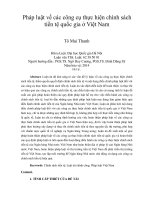Sách hay The de textbook the stuff you didn’t know about the stuff you thought you knew
Bạn đang xem bản rút gọn của tài liệu. Xem và tải ngay bản đầy đủ của tài liệu tại đây (23.26 MB, 270 trang )
EDITOR IN CHIEF
Jack O’Brien
EXECUTIVE EDITOR
David Wong
HEAD WRITER
Daniel O’Brien
SENIOR EDITORS
Michael Swaim, Robert Brockway, Soren Bowie, Kristi Harrison, Adam Tod Brown, Cody Johnston
CONTRIBUTORS
Jacopo della Quercia, Robert Evans, C. Coville, Eddie Rodriguez, Alexander L. Hoffman, Karl Smallwood, Cyriaque Lamar, Tom
Reimann, Maxwell Yezpitelok, S. Peter Davis, Christian Ames, R. Jason Benson, Kathy Benjamin, Danny Harkins, Eric Yosomono, Juan
Arteaga, David Dietle, Elford Alley, Pauli Poisuo, Christina H., Crystal Beran, Dennis Hong, Rohan Ramakrishnan, Cezary Jan
Strusiewicz, Clive Jameson, Evan V. Symon, Jake Klink, Levi Ritchi, Lola C., M. Asher Cantrell, Xavier Jackson, Adam Wears,
Brendan McGinley, Christian-Madera, Colin Murdock, Craig Thomas, Dan Seitz, David A. Vindiola, Geoffrey Young, J. F. Sargent, Jack
Mendoza, Jake Slocum, Jonathan Wojcik, Justin Crockett, Katherine Smith, Kenny Thompson, Kevin Forde, Mark M., Martin Bear,
Michael Voll, Mohammed Shariff, Nathan Birch, Philip Moon, Rob Sylvester, S. Peter Davis, Samuel Bloodthirst, Shayn Nicely, Steve
Kolenberg, Tom Lagana, XJ Selman
ART DIRECTORS
Monique Wolf, Randall Maynard
COVER ART
Adam Simpson
COPY EDITORS
Sheila Moody, Erica Ferguson, Andrea Reuter
SPECIAL THANKS
Becky Cole, Kate Napolitano, Jaya Miceli, Demand Media, Dan Strone at Trident Media Group, John Cheese, Sean Reiley, Chris
Bucholz, Wayne Gladstone, Luke McKinney, Ian Fortey, Alex Green, Kristin Plate, spouses, moms, dads
PLUME
Published by the Penguin Group
Penguin Group (USA) LLC
375 Hudson Street
New York, New York 10014
USA | Canada | UK | Ireland | Australia | New Zealand | India | South Africa | China
penguin.com
A Penguin Random House Company
First published by Plume, a member of Penguin Group (USA) LLC, 2013
Copyright © Demand Media, Inc., 2013
Penguin supports copyright. Copyright fuels creativity, encourages diverse voices, promotes free speech, and creates a vibrant culture.
Thank you for buying an authorized edition of this book and for complying with copyright laws by not reproducing, scanning, or
distributing any part of it in any form without permission. You are supporting writers and allowing Penguin to continue to publish books
for every reader.
Page 209 constitutes an extension of this copyright page.
Cracked is a trademark and/or registered trademark of Demand Media, Inc., in the United States and/or other countries.
REGISTERED TRADEM ARK—M ARCA REGISTRADA
LIBRARY OF CONGRESS CATALOGING-IN-PUBLICATION DATA
The detextbook : the stuff you didn’t know about the stuff you thought you knew / CRACKED.com.
pages cm
Includes index.
ISBN 978-0-698-15804-7
1. Common fallacies. 2. History—Errors, inventions, etc. 3. Errors, Scientific—Miscellanea. 4. Medical misconceptions—Miscellanea. I.
Cracked.com.
AZ999.D47 2013
001.96—dc23
2013022408
Version_3
For granting us continual existence through its inconceivable power, we dedicate this
book to the sun. Thanks for not eating us yet.
CONTENTS
The Authors
Title Page
Copyright
Dedication
Acknowledgments
Introduction
A Brief Recap of Your Squandered Education
CHAPTER 1
Health and Anatomy
Stuck inside an insane machine with a user’s guide made of lies
CHAPTER 2
Biology
The propaganda campaign to make you think all cool animals are dead
CHAPTER 3
World History
If it was written by the winners, they are boring liars
CHAPTER 4
Sex Education
Lies about your junk and how to use it
CHAPTER 5
Physics
The universe is an unpredictable magic show
CHAPTER 6
U.S. History
The (bullshit) superhero movie
CHAPTER 7
Health and Nutrition
Tricked into living fat and dying young
CHAPTER 8
Practical Psychology
How to keep your brain from screwing you
Credits
Acknowledgments
Even before our own mothers, the Cracked editors would like to thank the heaps of talented comedy writers who fearlessly throw their
ideas to the wolves every day in our Writer’s Workshop. Without their tireless hunt for all things fascinating and their long-suffering
tolerance of our fickle, occasionally drunken demands, this book would never have been possible.
We would also like to thank the wolves, those Workshop and forum moderators who believe in something greater than themselves, and
have inexplicably chosen a comedy website as that something. They never kill an idea or a profile without reverence and necessity, and
in doing so, maintain the precarious balance between fascist order and lawless swill hole that Cracked could collapse into without their
diligence.
We owe a huge debt of gratitude to Randall Maynard, Monique Wolf, and the rest of the design team for arranging every inch of this
book, as well as Andrea Reuter for her patient and flawless copyediting. The debt of gratitude, we should note, has no monetary value
because we already paid them handsomely. If they are shoeless and blackout drunk in a box somewhere today, that’s on them.
Thanks also to everyone at Demand Media, first and foremost Richard Rosenblatt, Shawn Colo, Stewart Marlborough, our PR,
marketing, sales, and especially our legal team for allowing us to continue this extensive, highly scientific experiment into the healing
properties of dick jokes. Also, thank you to the Cracked team including Abe Epperson, Adam Ganser, Breandan Carter, Mandy Ng,
Simon Ja, Billy Janes, Greg Shabonav, Stephen Lopez, Jason Gu, and Mitchell Thomas, who keep the entire site running.
We would especially like to thank Kathleen Napolitano and Becky Cole from Penguin, Jaya Miceli and Adam Simpson for designing the
polished cover you now hold in your strong and capable hands, and our agent Dan Strone from Trident Media Group for understanding
the importance of foul language and tasteful nudity.
Lastly, thank you to those once great leaders of Cracked who couldn’t be here today, Oren Katzeff and Greg Boudewijn. They are in a
better place now, at higher-paying jobs.
Oh shit, and our moms! Sorry, moms, for saying “shit” just now.
INTRODUCTION
A Brief Recap of Your Squandered Education
Welcome to school, the propaganda wing of your parents’ battle to win your hearts and minds, or at
least get you to “quiet down for a single goddamn second before Mommy does something crazy.” An
annoying number of pointless questions are going to start popping into your head. You come into the
conscious part of your life as a barely contained vortex of pure uncut curiosity, and the people in
charge of your education are like Danny Glover in the Lethal Weapon movies—counting down the
days until they’re able to retire with some peace and quiet, and most assuredly too old for this shit.
The Sacred Pact of the Bad Teachers Alliance
Teachers are fighting a nonstop battle to bring the energy in the room down to their level, which
meant there was some stuff they couldn’t tell you about. Because the truth is, and don’t tell them we
told you this, the world around you is fucking amazing. It’s just way easier to manage a classroom full
of children on the verge of falling asleep than one that is vibrating with sheer, joyous energy because
nobody can freaking believe how goddamn amazing blue whales are!
And so, they edited the coolest stuff out of the stories they taught you, inundated you with dates and
names and other curiosity-dampening instruments to clog the information-craving hole in your brain
that churns out questions like, “Yeah, but why is the stuff inside of the leaves green?”
One thing is for certain: They never came clean about completely biffing your education, which is
how you came to construct your view of the world on a foundation of lies and half-truths that totally
missed the point.
For Instance . . .
In case you’re wondering what they could have gotten so terribly wrong, here’s a quick preview of
one of the incredible history lessons nobody taught you. Bear with us, because this is weird. And it
has massive implications for everything you’ve ever read on any subject ever.
Homeric scholar William Gladstone was going through The Iliad for the thousandth time when he
noticed something odd. Despite being one of the best poets ever to put pen to paper, Homer sucked at
describing colors. He described the ocean, oxen, and sheep as being the color of wine. He described
honey and a nightingale as being green, and the sky as being bronze. At one point he described
Hector’s hair as being the color of a stone that we know to be blue. Gladstone, who was so smart that
he’d eventually become the prime minister of England four times, started going through and counting
all the colors referenced in the book. There were thousands of blacks and whites, a handful of reds,
yellows, and greens, and, assuming Hector wasn’t a Smurf, no blue at all.
Following Gladstone’s lead, scholars expanded the search for the color blue in ancient Greek
writing. Nothing in Aristotle. Even the color theorist Empedocles didn’t mention it, and writing about
colors was sort of his thing. Ancient Greeks not only seemed to not have a word for blue but also
didn’t seem to be able to perceive the color at all. Realizing that the cone receptors in our eyes
couldn’t have changed that much over the course of three thousand years, the scholars were forced to
conclude that it was some rare mental block.
But as academics and historians from different fields began comparing notes, they realized that it
wasn’t just the ancient Greeks. Colors seemed to emerge in stages. In the early days, colors started as
black and white. Aristotle described colors as the presence and absence of light, and he was the
smartest dude ever to exist anywhere. Next, the concept of colors would blink into existence one at a
time. Red would show up first, then green and yellow would eventually arrive on the scene. Without
fail, blue would always show up last.
A loose theory has emerged that it’s need based. Cultures take their lazy old time, not inventing
colors until they need them. Red comes first because it’s the color of blood and wine, two of the only
fluids with color that are in abundant supply in the early stages of a civilization. Green would usually
come next because it’s the color of foliage and can be useful in differentiating one leaf from another.
But in most places in the world, the only thing that’s naturally blue is the sky. And if sky blue is the
only type of blue you ever see, why have a word for it at all?
So Homer was writing at a time somewhere around the invention of yellow—he uses it, just not
very well—and about five hundred years before blue arrived and freed ancient Greek artists to take
reality from black and white to Technicolor (see here). What’s amazing is that not having a word for
blue made him see the world the way someone might if they were wearing glasses that filtered out all
blue light. Put on a pair of blue blockers and the sea probably does look like wine, and the sky
bronze. In a recent experiment, a man actively shielded his daughter from the word “blue” for the first
four years of her life and found that on a clear day she would simply describe the sky as white, and
blue things as other colors, because her mind hadn’t invented the existence of blue.
This means that language is not some separate code that we use to describe a set of preexisting
things. Language gives us the ability to perceive them. Probably the greatest modern example of this is
the Aboriginal Australian tribe that invented the word “kangaroo” but never got around to inventing
words for “right” and “left.” Instead, they related everything to its position on the compass. Rather
than making them worse at orienting themselves, not having the concept of left and right gave the tribe
a superhuman sense of direction: They could be chasing an animal in circles through the forest on a
moonless, pitch-dark night in the middle of a downpour and they would know exactly where true
north was at all times.
Think about what that means for history. We’re not just the newest link on a chain of identical
iterations of humankind. The world you perceive might be completely different from the one being
observed and recorded in historical documents. Think about how much more interesting history class
would have been if you’d realized that every new era offered you the ability to see the world in a
completely new way and solve the mystery of what words and ideas people possessed at a given
time, and what they didn’t. Think about how much more interested you would have been in the world
around you if they’d just taught you that there are types of human perception and abilities that you
can’t even conceive of because nobody’s given you the tools necessary to describe them in your head.
That could have changed your life!
But it’s easier to test your ability to remember names and dates, so they just made up a bunch of
those, taught you how to memorize them, and called it a day. This book is our attempt to erase the
layer of black and white gunk they painted over some of the most surprising truths mankind has found
out about so far. It is full of information that you will be furious you weren’t taught the first time
around, and lies you won’t believe you fell for. And dick jokes. There will be plenty of those, too.
FIGURE 1.1
Fun fact: The most disgusting part of the body is literally the entire thing.
1
Welcome to Your Body!
Here’s Some Bullshit We Made Up About It
Naturally, you’re curious
about this meat suitcase you find yourself locked inside. From the time that you enter kindergarten—
not knowing your ass from elbow macaroni, and unwilling to take “I don’t know” for an answer—on
through the stage when puberty flushes everything that isn’t hormones from your bloodstream and well
into adulthood, you’re going to have lots of questions about the soft pile of tissue you’re stuck
piloting. Unfortunately, your parents and teachers won’t let you learn enough about human anatomy to
know what part of their body they’re pulling the answers out of.
The Five Senses
THE MYTH: You perceive the world around you with five senses.
When someone says they have a sixth sense, it means they’re a crazy person. Believing there are more
than five senses is for television psychics and M. Night Shyamalan.
FIGURE 1.2
While none of Johnny’s “five” senses are bringing in new data, his brain still senses that we’ve made him stare at this
blank wall for more than three hours. After talking to his classmates, his sense of time will tell him that these were
the same three hours when they did an experiment to find out which ice cream makes time go the fastest. (Answer:
the best-tasting ice cream!)
Class Discussion!
Should Johnny have doubted his teacher about having a clock in his brain, even though he doesn’t know shit?
THE TRUTH: The five senses you’re familiar with aren’t even the most
important ones.
For instance, think about your sense of time—the inner clock that tells you how long something is
taking. Don’t think you have a clock ticking away inside your brain? Try staring at a white wall in a
totally silent room. Your sense of time is what tells you how much of your life has been wasted
because you doubted us (see Figure 1.2).
If you’re walking in the woods and a bear growls in the bushes over your left shoulder, the sound
hits your left ear a millionth of a second before your right. Your sense of time picks up on that tiny
difference and allows you to perfectly triangulate the bear’s location. If you had only five senses,
you’d have to use your eyes to locate the bear, and by then it would be too late. A blur of brown fur
would be the last thing you ever saw!
The Tongue Map
THE MYTH: Your tongue has specialized zones responsible for detecting
certain tastes.
FIGURE 1.3
What you learned the tongue looks like in action: a ladybug that knows how to party.
You saw this colorful diagram in an elementary school textbook and you might have even sat through
a classroom experiment where you placed different flavors on different parts of your tongue to show
you that your taste buds stick to their own in segregated taste zones, presumably fighting little salty
versus sweet gang wars on the borderlands whenever you eat a chocolate-covered pretzel.
THE TRUTH: Your tongue is like your digestive system’s fingerprint.
FIGURE 1.4
What the tongue actually looks like: a ladybug that’s freaking out, you guys!
The idea that strictly defined areas of the tongue respond to particular tastes started much in the same
way that we expect the next world war to start . . . with Americans failing to grasp the translation of
words written in a foreign language. In 1941, a Harvard academic with the comically ideal name of
Dr. Boring (seriously) mistranslated a 1901 German study, erroneously interpreting it to mean that
certain areas of the tongue react more strongly to certain tastes. The first red flag should have been the
fact that German food only has one taste: sauerkraut.
Rather than identifying a precise map of the tongue, that 1901 German study just concluded that
some people react to different tastes on different parts of the tongue more strongly than others, which
is pretty much spot-on. Each of our “tongue maps” will react to different tastes in different ways,
sometimes detecting different flavors in the exact same meal. As for taste buds, they aren’t just on the
tongue but instead stretch all the way down the esophagus into the stomach. When you eat something
that makes you nauseous, it’s the taste buds in your stomach that tell the rest of your digestive tract
that the train is coming. We blame pressure from the notoriously strong Colorful Chart Industry lobby
for keeping this myth alive in classrooms a full thirty years after it was debunked.
Deoxygenated Blood
THE MYTH: The blood inside your veins is blue, only turning red when
exposed to oxygen.
This one is simple. White people, look at the underside of your arm right now. See all those veins?
They’re blue, right? That’s because the blood coursing through them is also blue. It only turns red
when it mixes with oxygen, a scientific process that those who have witnessed it have rated as
“totally not worth it.”
FIGURE 1.5
Bleeding to death on Earth versus bleeding to death on the moon: both probably terrible.
THE TRUTH: Blood comes in two colors—red and even more red.
Deoxygenated blood isn’t blue. Those veins we asked (demanded, actually) every white person look
at also aren’t blue. The veins and the blood they carry are not only red; they’re even redder than
oxygenated blood. That blue? That’s just your eyes playing tricks on you. The fact that you can see
them at all is due to how close they are to the surface of the skin.
The color change can be chalked up to the fact that light reflects blue through Caucasian skin,
unlike how it reflects through the skin of other races, whose veins can look brown, green, or pink.
Basically, blue blood was one of those “scientific discoveries” that probably happened when some
white guy noticed something that was true about his race, briefly considered checking with people of
different races, then remembered who was the white guy here and went back to his job deciding what
color to make Band-Aids.
Body Heat
THE MYTH: You lose most of your body heat through your head.
Listen up, this is just common sense. Heat rises. And where is your head? It’s on top of your body. So
naturally, when heat escapes your body, it leaves through your head (see Figure 1.6). Now quit asking
questions and put this hat on. It looks like a panda’s head. So not only will it keep you warm, but
chicks will dig it, too.
THE TRUTH: Covering one part of your body has as much effect as covering
any other.
The myth that heat escapes your body through your head is based on what could very well be the most
poorly executed study ever conducted. In 1951, the U.S. Army tossed a bunch of test subjects wearing
the latest in arctic survival gear out into the freezing cold and measured how much body heat they
lost. One thing, though—they didn’t bother to put hats on them. Shockingly, most of the measured body
heat escaped through their uncovered domes. Who could have seen that coming? The army was so
proud of this groundbreaking discovery that it published the finding in a survival manual and stressed
that hats were mandatory survival gear. Just like that, your mother had something to nag you about for
the rest of her blessed time on this earth. The truth is, an uncovered head loses no more body heat than
any other uncovered body part and gets you less jail time than a few of them.
FIGURE 1.6
A man doffs his hat to a passing woman—the number one cause of hypothermia and global warming according to
some bullshit your mom learned from the army.
Corrected User’s Manual to You
THE MOST BASIC THINGS YOU’RE ALMOST CERTAINLY
DOING WRONG
There are certain aspects of life that,
thankfully, seem to come preinstalled—simple things that your body figures out almost instinctively
so you can save all of your precious focus for cartoon plotlines and the instructions on the backs of
shampoo bottles. There’s only one problem: You’re doing every single one of those things
incorrectly, and it’s killing you.
Most of the things that your body does instinctively are actually behaviors you’ve learned by
watching your parents and the people around you. And humanity has picked up some pretty terrible
habits over the years. For instance . . .
Corrected User’s Manual to You: SITTING
HOW YOU DO IT
In a chair, at a 90-degree angle,
which it turns out is the worst thing you can possibly do to your body that isn’t smoking. Your parents
warned you about posture but forgot to mention that just sitting in a chair leads to a lower life
expectancy and increased risk of diabetes, heart disease, and cancer. You’d be better off connecting
that chair to thousands of volts of electricity and getting it over with.
It seems like the most natural thing in the world, but sitting in a chair is a relatively new
development. Prior to the past few centuries, you could sit on a backless stool or bench, or you
kneeled. We’ve still got terms like “chairman” that show how uncommonly high you had to get in an
organization before they gave you something to lean back against.
Now that everyone gets to sit in a chair all day like fancy millionaires, the core muscles that used
to hold us together are turning into pudding, which is apparently really bad for you. So bad that
people who work a desk job and exercise regularly die younger than people in careers that require
them to stay on their feet.
HOW YOU’RE SUPPOSED TO DO IT
Look at that weird guy in the office
who sits on a giant inflatable ball. Ugh. As much as we hate to say it, the best way to keep your abs
from taking the day off is to engage them by challenging your ass with a seat that requires some degree
of balance and precision. Think a backless stool, a bench, or, if all those things burned down, a
bouncy, pastel-colored yoga ball.
You can also avoid the Sitting Death by kneeling, crouching, standing, or continuously performing
jump-squats and roundhouse kicks while at your desk, at the dinner table, on roller coasters, or
anywhere else you’d usually sit. Another option is to constantly recline at least 135 degrees, which
has been shown to provide some relief to the spine but also increases tenfold your chances of falling
asleep at work.
So if you don’t feel like being “that guy with the ball,” getting fired, or ratcheting all your tables at
home up to standing height, your best bet is to spend as much time as possible at the stool’s natural
habitat: the bar. Do it for your health.









